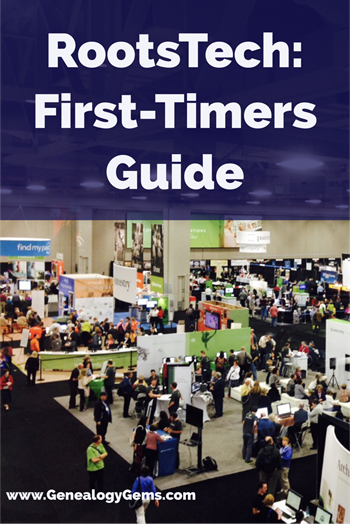Blog

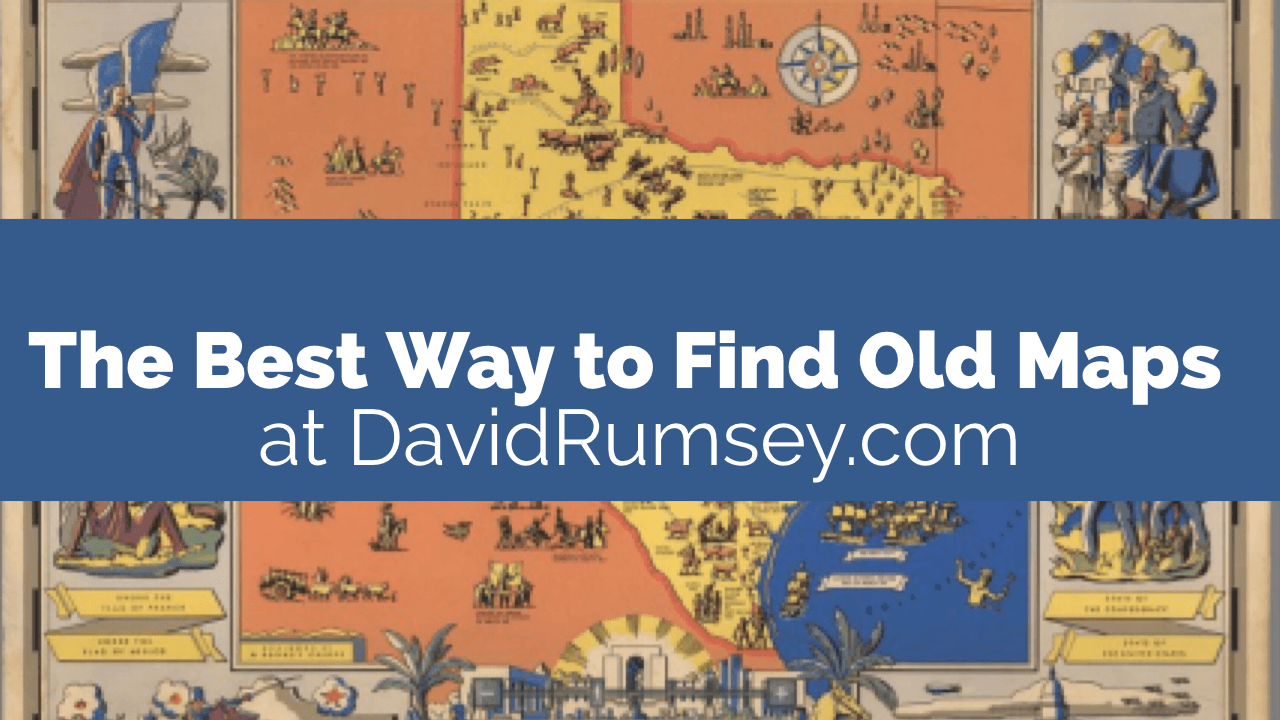
The Best Way to Find Old Maps for Genealogy at the David Rumsey Website
Old maps are vitally important for genealogy because the characteristics of a location can change in many ways over time. Historic maps help us understand the world as it was at the time our ancestors lived.
Here is a short list of just a few of the things that may have changed:
- Street addresses
- roads
- town names
- county boundaries
- waterways that may have been filled in or opened up
- railway lines
In fact, the country itself where they lived may be a completely different country. For example, my German ancestors lived in Prussia in the 19th century. Today, that area is part of Poland. Therefore, all of the village names have been changed to Polish names.
The David Rumsey Map Collection is an excellent place to go to find maps of your ancestors homeland for free.
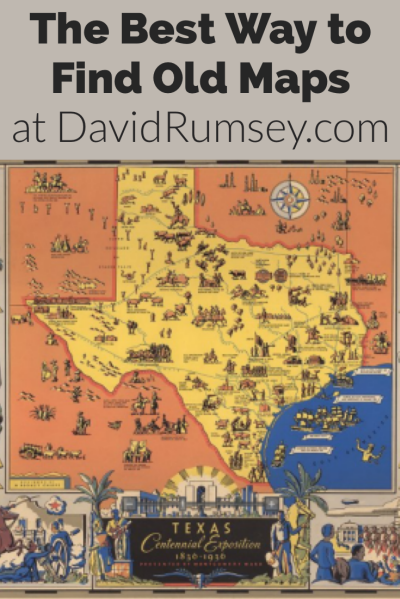
Watch the Map Search Video
I’m going to explain the 7 steps to finding the maps you need for your genealogy research at this wonderful website! I highly recommend that you watch the short video below to see it in action as you read. The player will stay with you as you scroll down the page.
Step 1: Go to the David Rumsey Map Collection Website
The first thing you need to do is go to the David Rumsey website here. You’ll be greeted on the home page with glorious historic maps. (Stay focused because it’s easy to get distracted by all the fascinating maps!)
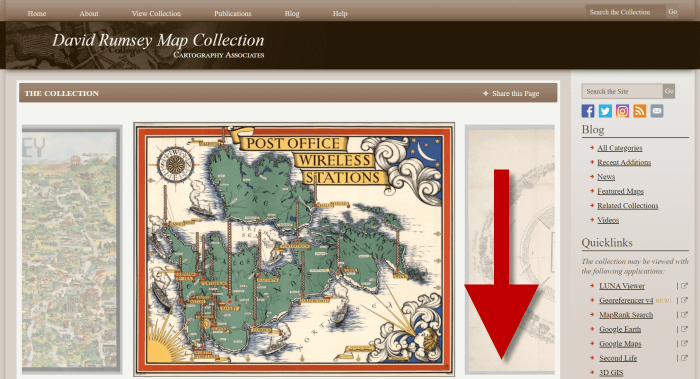
Scroll down on the David Rumsey website home page.
Step 2: Scroll Down to the Bottom of the David Rumsey Home Page
While you can search for a place name in the search box at the top of the page, there’s a better way to search. Scroll down the page until you get to Featured App: MapRank Search (it’s almost at the bottom.)
Step 3: Launch Map Rank Search
The Featured App – MapRank Search is the best place to search the website, but it’s easy to miss because it’s not at the top. So go ahead and click the Launch MapRank button in the upper corner of this section.
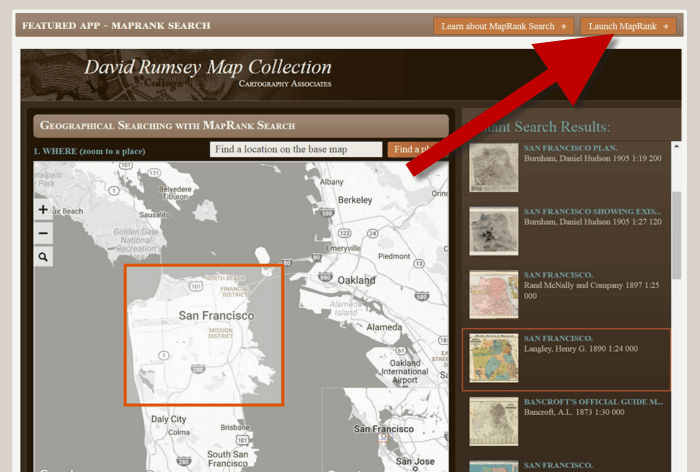
In the Featured App: MaprRank Search section click the Launch MapRank button
When you click the button it will open a new tab in your web browser which will take you to the Geographical Searching with MapRank Search page.
Quick Tip: The Fastest Way to MapRank Search
You can get there faster by going directly to https://rumsey.mapranksearch.com. I didn’t take you straight there from the beginning because I think it’s important to be aware of the home page and everything else it offers. However, today our focus is conducting the optimal search for old maps for you family history.
Step 4 Selecting the Map Time Frame
Here’s what the search page looks like.

The DavidRumsey.com search page
There are two very important features on this app page that will help you get the best results possible: the time slider and the location search box.
The time slider is located beneath the map:
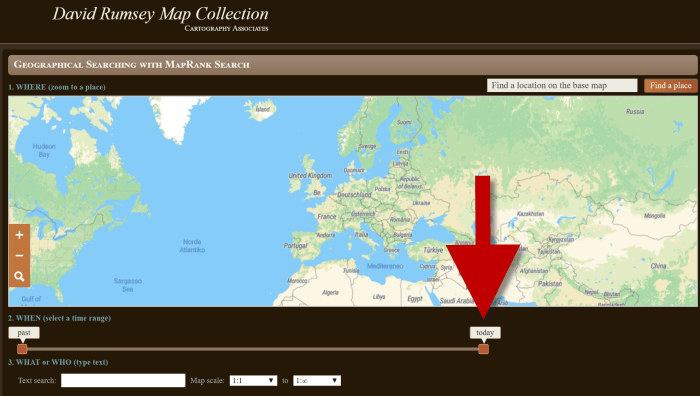
Time Slider for searching maps by time frame
It’s important to first select the time frame that you are searching because that will dictate the results you get when you search on the location name. (We’ll get to that in just a moment.)
There is a slider on each end of the timeline. Slide them to specify the desired time frame. In my example below, I’m looking for maps between 1800 and 1900.

Searching for maps between 1800 and 1900
As you move the sliders, you’ll notice that the maps in the right hand column will change. This is because only maps that fall within the range you select will be offered in the Instant Search Results column. But before we look at those, we need to type in a location in the next step.
Step 5: Selecting the Location
With your time frame selected, now you’re ready to type the location in the search box.
As you type, the app will make suggestions. But wait! Before you click the Find a Place button to run the search, look carefully at the list of suggested locations that may appear. Many locations names can be found in different areas. That is certainly the case with the name of the tiny village where my great grandfather was born: Kotten.

Type the location name to search the maps
In fact, the list doesn’t even include the Kotten I am looking for.
In cases like this, it is best to search a little more broadly. When Kotten was part of Prussia, it was located in Kreis Johannisburg so I could try searching for that. Even better might be to search for the largest city in the area since Kotten was such a tiny village. Arys was the largest city in the area.
Once you type in the name (and select from the suggestions if needed) click the Find a Place button just to the right of the search box.
Step 6: Analyze the Map Results
In my example of searching for the city of Arys (which is the name it was known by in the 19th century when it was part of East Prussia) the modern-day map displayed is actually Poland.
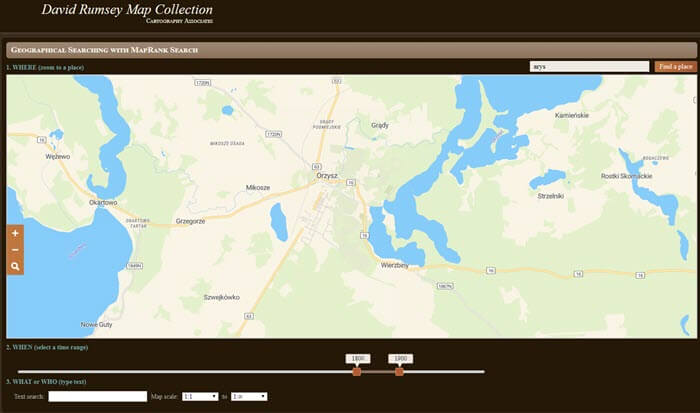
My search resulted in a map showing Orzysz, Poland
However, the David Rumsey website does a good job of cross-referencing the older German names (Arys) with the new Polish names (Orzysz). This is another reason why searching for a larger city works well. Larger cities are more likely to be in the David Rumsey system for cross-referencing, and of course they are easier to spot on the map. Generally speaking, the location you searched will be in the center of the display map.
Quick Tip: Verifying Location Names
Another quick way to cross-reference location names (or verify your findings in David Rumsey) is by searching for the name in Google Earth. In the example below, I typed in the Prussian city of Arys. Google Earth will offer options if more than one matching result exists.
I was a bit surprised to see “Arys” as one of the three listed results since it is not called that today. When I clicked Arys it took me to the city of Arys in the Turkistan Region of Kazakhstan, far away from Poland! Clicking Orzysz in the results list took me to the area of Poland that was once East Prussia. This confirms the results I received at the David Rumsey website.
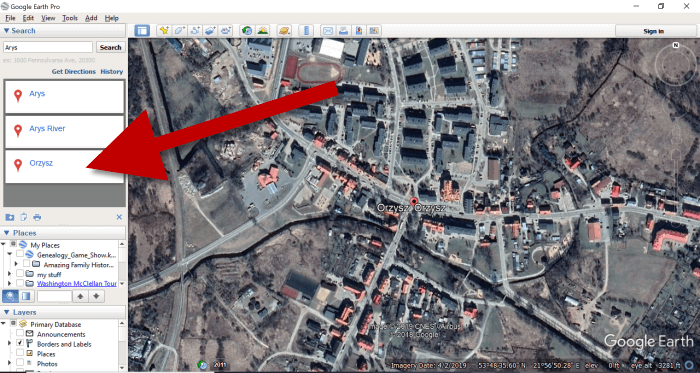
Learn more about using Google Earth for Genealogy by watching my free class here.
Now it’s time to review the map results listed in the Instant Search Results column on the right. Isn’t it fantastic that David Rumsey’s website not only presented me with the correct Polish location, but also maps published between 1800 and 1900 that include Arys? I think so!
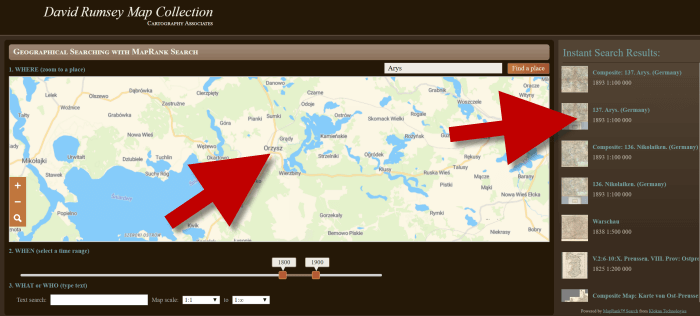
Map results appear in the column on the right side of the page.
Click the map you think best suits your needs. The map will open in in a new tab in your web browser. (These browsers tabs provide a nice bread crumb trail for your searching activities.)
All of the source information about the historic map that you chose will appear in the column on the left. (See the image in Step 7.) If you decide to use this map you’ll definitely want to accurately cite the source. Learn more about the importance of source citations here.
Step 7: Export the Map
I was delighted to find the village of Kotten on this map of Arys published by Reichsamt fur Landesaufnahme in 1893!
When you find a map that you would like to use for your family history research, export it to your computer. To do this, click Export in the upper right corner of the map and select the desired size. You can select a size ranging from Small Thumbnail to Extra Extra Large. Keep in mind that the larger the size, the more clarity you will have as you zoom in closer and closer. This is very important if you plan on using the map in an overlay in Google Earth. You can learn how to create your own map overlays in my video tutorial series on using Google Earth for genealogy available here, and in my book The Genealogist’s Google Toolbox.

Click “Export” to save the map to your computer.
Be patient while downloading to your computer because it can take several moments to export a large map. The saved file will probably be zipped. To unzip it, on a PC right-click and select Extract All from the pop-up menu. This creates an open version of the folder containing the map.
Get Started Finding Your Ancestral Locations in Old Maps
With this step-by-step process you are now ready to explore any given ancestor’s world through the rich details of historic maps. I can’t wait to hear what you discover! Please be sure to leave a comment below. And if you found this tutorial helpful, will you please share it with your friends on social media so we can help even more people find the homes of their ancestors? Thank you!

RootsTech 2020 SLC Opens Registration
It’s time for genealogists to start making plans for the RootsTech 2020 conference to be held in Salt Lake City, Utah.
I’ve been attending and speaking at RootsTech since 2011, the second year that the conference was held. It’s been so rewarding to be a part of the evolution of this event! This 10th anniversary in 2020 promises to top them all.
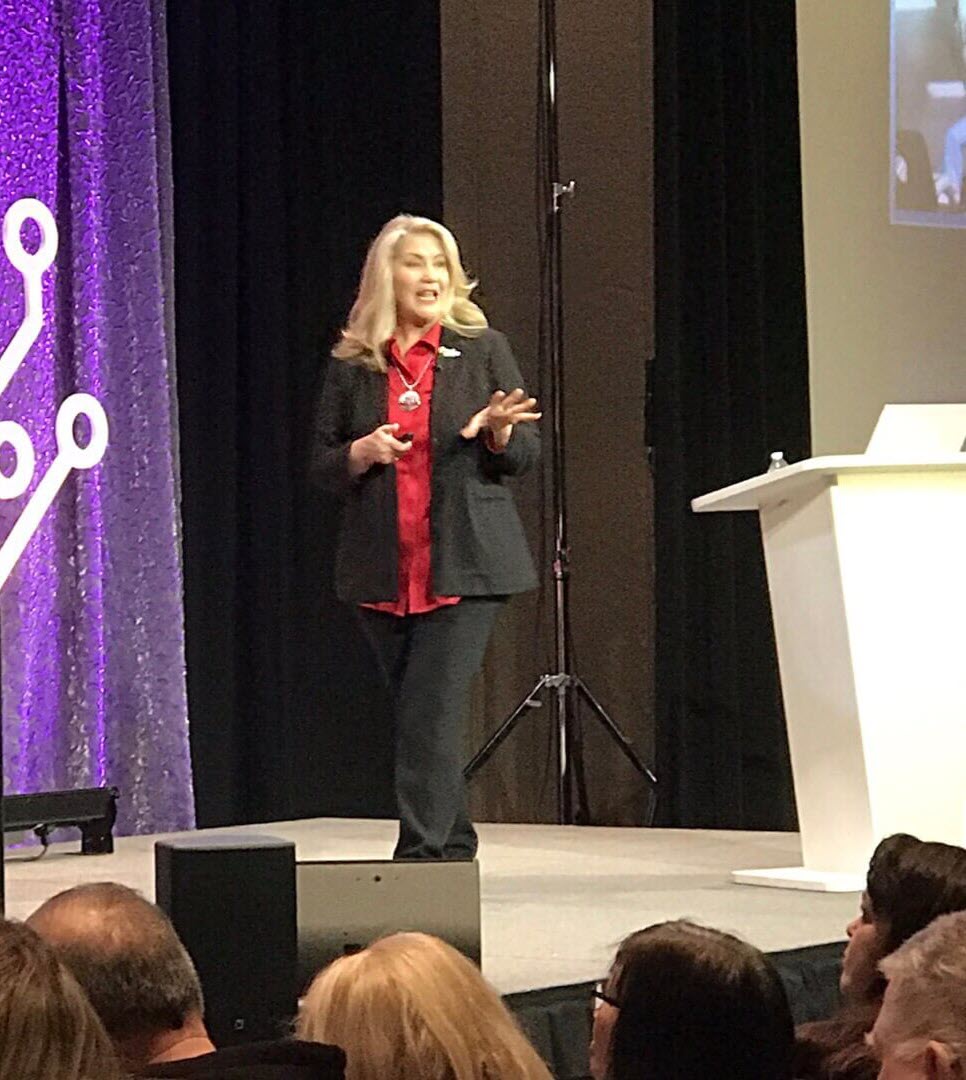
I’ll be delivering four presentations this year:
- Reconstruct Your Ancestors’ Stories with Google
- Genealogy in Your Ears: Podcasters Talk Podcast
- 3 Cool Cases Solved: How to Identify Your Photos (premiering at RootsTech!)
- The 2020 Genealogist’s Google Search Methodology
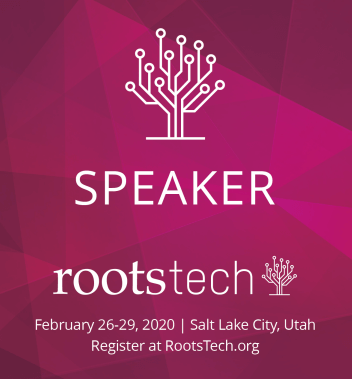
Each year holds new surprises and opportunities to connect with your fellow genealogists. Below is the recent RootsTech press release providing all the details on registration. And here’s a tip: If you’re travelling from out of town, book your accommodations right away. Some hotels have already sold out.
RootsTech crowds enjoy the many attractions of the popular annual event.SALT LAKE CITY (18 September 2019)—
FamilySearch International has announced that registration for RootsTech 2020 Salt Lake City is now open.
RootsTech is a popular 4-day annual family history and technology conference where individuals and families are inspired to discover, share, and preserve their family roots, heritage, and stories.
The 2020 conference will be held February 26–29, 2020, at the Salt Palace Convention Center in Salt Lake City, Utah. For more information, visit rootstech.org/salt-lake. Discounts are available for early registrations.
In 2019, RootsTech attracted over 20,000 attendees from 38 different countries and all 50 states.
RootsTech 2020 will celebrate its 10th anniversary and the distinguished honor that it is the largest genealogy conference of its kind in the world.
The conference will feature a full lineup of inspiring and well-known keynote speakers, over 300 informative sessions, including hands-on computer workshops taught by industry professionals; interactive activities and helpful exhibitors in the expo hall; and entertaining events—all designed to inspire and empower personal family discoveries.
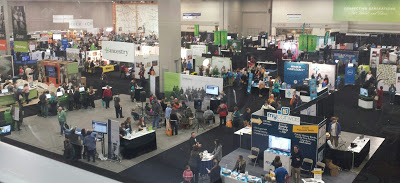
Conference Details
The theme for RootsTech 2020 will be “The Story of YOU.” Many of the classes, keynote address, and venue décor will reflect this theme.
“At RootsTech, we believe that the stories we’re creating and preserving today are just as important as the stories of our ancestors,” said Jen Allen, event director. “Reflecting on and celebrating each of our personal journeys is an important part of family history that we are excited to explore at the 2020 conference.”
RootsTech 2020 will also introduce learning forums—new class sessions covering a variety of specialized topics including: records access and preservation, innovation and technology, and DNA. One of these forums will be offered on Wednesday, Thursday, and Friday.
RootsTech 2020 will officially begin on Wednesday, February 26 with class sessions beginning at 8 AM MT. Wednesday’s general keynote session will begin on the main stage at 4:30 p.m. Steve Rockwood, CEO of FamilySearch International, will be the featured keynote speaker.
General keynote sessions on Thursday, Friday, and Saturday will begin on the main stage at 11 AM MT and will lead directly into the lunch hour.
Read more about what’s new at RootsTech 2020.

RootsTech Conference Pricing
Early bird discount pricing is available for a limited time on 4-day passes at just $169 (a $130 discount on regularly priced passes). Single day RootsTech passes are also available for $99. Both one-day and full conference passes include access to the popular expo hall and keynote sessions. Early bird pricing ends October 11, 2019.
Family Discovery Day at RootsTech 2020
Registration for Family Discovery Day is also now open.
The event takes place on Saturday, February 26, 2020, and is designed for families and members of The Church of Jesus Christ of Latter-day Saints.
This free 1-day event includes inspiring messages from Church leaders; engaging classes for families, youth, and young single adults; and evening entertainment to inspire and help families make family history connections.
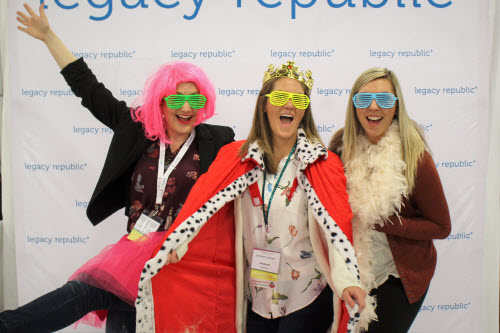
My kids and their friend having fun at RootsTech
Family Discovery Day attendees will also have access to all the interactive activities and exhibitors found in the RootsTech expo hall. Event details, including speakers and class sessions, will be made available soon at RootsTech.org.
The event is free, but registration is required.
Considering Going for the First Time?
If you’ll be attending RootsTech for the first time, we’ve got loads of tips that will help make your experience awesome. Read my article RootsTech questions: Tips for attending world’s biggest genealogy event.
Looking for a Smaller Genealogy Event?
If you enjoy a more intimate genealogy event setting, consider joining me at Genealogy Roots. It’s two days of genealogy education with me and my special guest Geoff Rasmussen of Legacy Family Tree Webinars. It’s coming soon: October 10 & 11, 2019 in Sandy, Utah, just 25 minutes south of the Family History Library in Salt Lake City. Learn more and get the early-bird special on tickets here.


Genealogy Records Just Keep Coming Online! (and we love it!)
If there’s one thing we want to see coming online every single day, it’s new digitized genealogy records! A genealogical brick wall that has been sitting dormant for years can be broken down if just the right records becomes available. And we never know when that will happen.
This week I’m sharing some of the genealogy records that have come online in the last few weeks. These records comes from across the United States. They include wills and probate, police and mug shots, and cemetery records. Perhaps your ancestor’s record is among them.
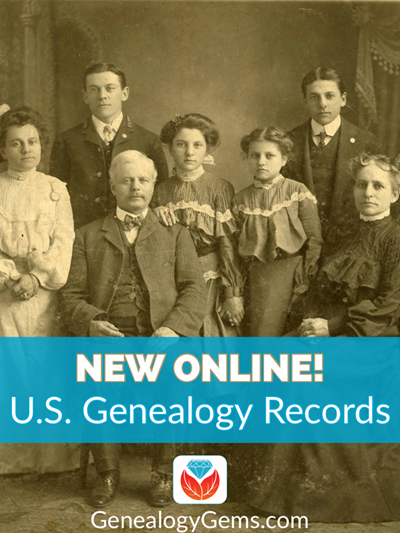
Wills and Probate Records
Do you have ancestors’ from Maryland? Search this collection of Wills and Probates at Findmypast to find out the date of their Will.
As confirmed in the introduction of the publication, the Maryland Calendar of Wills was compiled in response to an already “long existent and steadily increasing need for such work, a need not only of genealogists, nor only for Marylanders now living in the State, but also for the large class of persons, whose ancestors are to be numbered among the men and women who took part in the nation-building as begun on Maryland shores, and whose descendants are now to be found in every State of the Union.”
Each record is available in a PDF format. Use the previous and next buttons at the top of the page to browse through the publication.
The General Index of Wills of St. Mary’s County, Maryland, 1633 to 1900 was compiled by Margaret Roberts Hodges from original indices, the collection of records were published by the Carter Braxton Chapter of the Daughters of the American Revolution.
You can also Search this index to more than 107,000 probate records from Maryland between 1634 to 1777 for transcripts and images of both Prerogative Court and County records. The amount of information listed in each record will vary but looking at images is always recommended.
Preceding the implementation of the first Maryland State Constitution in 1777, two sets of probate records were maintained, probate business was conducted at the capital by the central agency which, for most of the Colonial period, was known as the Prerogative Court.
The Commissary General was the presiding officer of the court and a Deputy Commissary was then appointed for each county. The Deputy Commissary recorded each probate record that was brought into their office, periodically they would send the papers filed in their office to the Prerogative Court where they would be recorded again.
Mugs Shots and More Going Back 150 Years
Records from the Indianapolis Fire Department and the Indianapolis Metropolitan Police Department have been digitized and are available online.
Thanks to a $1.8 million grant from the Lilly Endowment, The Central Library in Indianapolis recently unveiled the collection, which includes some items dating back 150-years.
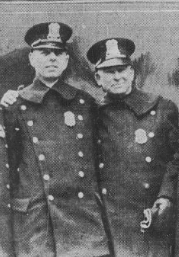
The items have been added to an existing collection of from the Indianapolis Firefighters Museum and include:
- log books,
- dispatch recordings,
- personnel records,
- newsletters,
- historical photos and
- prisoner mug shots
IMPD Deputy Chief Michael Spears said “The City of Indianapolis has a police department of which it can be extremely proud. This collection is the most complete and definitive collection of documents, photographs, videos and other exhibits ever compiled.”
“The Indianapolis Fire Department has a rich and proud 160-year history, and through our partnership with the Indianapolis Public Library, we are preserving that history for future generations,” said Tom Hanify, Professional Firefighters Union of Indiana President.
You can search this unique collection for free at http://www.digitalindy.org/ If you have family history rooted in the Indianapolis area, you’re in for a treat because the website include a wide range of historical content!
118,000+ New Cemetery Records Added
From Internment.com: Interment.net added 118,768 new cemetery records since our last report (January 2018), covering 49 cemeteries across 14 states.
Interment.net is one the oldest and largest archives of cemetery transcriptions, since 1997, and is still committed to serving genealogists at no cost.
Contained on our website are tens of millions of records, covering tens of thousands of cemeteries, from across the world.
Our records are obtained from databases direct from cemeteries, churches, libraries, and government offices, as well as from complete works of tombstone transcriptions.
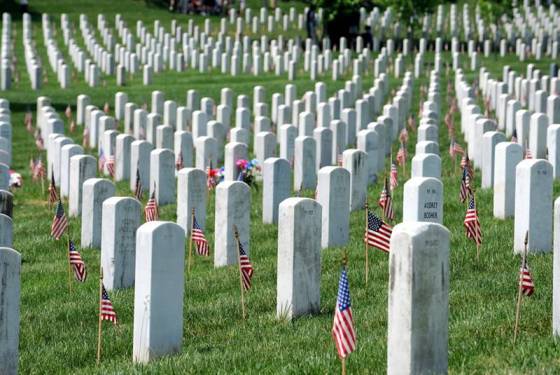
Here’s the list of cemetery records published recently:
Quebec, Canada
Brome County, Saint-Cajetan Cemetery, Mansonville, 722 records
Arthabaska County, Lorne Cemetery, Kingsley Station, 63 records
Arthabaska County, Trout Brook Cemetery, Tingwick, 127 records
Temiscouata, Cabano Cemetery, Temiscouata-sur-le-Lac, 2,117 records
Ontario, Canada
Bruce County, Culross and Teeswater Cemetery, Teeswater, 2,268 records
Ireland
County Wexford, Ballyhuskard Graveyard, Ballynastraw, 120 records
Alaska
Ketchikan Gateway Borough, Bayview Cemetery, Ketchikan, 5,291 records
Arizona
Apache County, St. Johns Cemetery, St. Johns, 1,400 records
California
Monterey County, Holy Trinity Cemetery, Greenfield, 500+ records
Monterey County, Oak Park Cemetery, Greenfield, 500+ records
Napa County, Pioneer Cemetery, Calistoga, 950 records
Los Angeles County, Fairmount Cemetery, Azusa, 250 records
Michigan
Genesee County, Garden of Peace Cemetery, Swartz Creek, 56 records
Genesee County, Swartz Creek Cemetery, Swartz Creek, 261 records
Clinton County, Rose Cemetery, Bath Township, 1,442 records
Clinton County, Pleasant Hill Cemetery, Bath Township, 1,806 records
Minnesota
Carver County, Chanhassen Pioneer Cemetery, Chanhassen, 850 records
McLeod County, Oakland Cemetery, Hutchinson, 8,755 records
Anoka County, East Bethel Cemetery, East Bethel, 100 records
Anoka County, Old East Bethel Cemetery, East Bethel, 178 records
Anoka County, Oak Leaf Cemetery, East Bethel, 650 records
Missouri
New Madrid County, Evergreen Cemetery, New Madrid, 2,500 records (approx)
New Madrid County, Davis Cemetery, Kewanee, 14 records
New Madrid County, East Side Cemetery, New Madrid, 128 records
New Madrid County, Cedar Grove Cemetery, New Madrid Township, 25 records
New Madrid County, A.C. LaForge Cemetery, New Madrid Township, 4 records
New Madrid County, Augustine Cemetery, New Madrid, 2 records
New Madrid County, Byrne-Howard Cemetery, New Madrid, 32 records
St. Louis County, Eberwein Family Cemetery, Chesterfield, 9 records
St. Louis County, Harugari Cemetery, Manchester, 21 records
St. Louis County, St. Mary’s Cemetery, Hazelwood, 1,071 records
St. Louis County, St. Monica Cemetery, Creve Coeur, 801 records
St. Louis County, St. Peter Cemetery, Kirkwood, 3,589 records
St. Louis County, St. Ferdinand Cemetery, Hazelwood, 3,426 records
St. Charles County, Ste. Philippine Cimetiere, St. Charles, 369 records
Jefferson County, St. Vincent Cemetery, Fenton, 33 records
Nebraska
Scotts Bluff County, East Lawn Cemetery, Mintare, 1,900 records
New York
Allegany County, Mount Pleasant Cemetery, Houghton, 724 records
Allegany County, Caneadea Cemetery, Caneadea, 430 records
Allegany County, East Caneadea Cemetery, Caneadea, 102 records
North Carolina
Nash County, Rocky Mount Memorial Park, Rocky Mount, 4,192 records
Ohio
Montgomery County, Happy Corner Cemetery, Englewood, 600 records
Oklahoma
Comanche County, Ft. Sill National Cemetery, Elgin, 6,093 records
Pennsylvania
Elk County, Denison Family Cemetery, Jay Township, 3 records
South Carolina
Anderson County, M. J. “Dolly” Cooper Veterans Cemetery, Anderson, 2,811 records
Richland County, Fort Jackson National Cemetery, Columbia, 5,548 records
Tennessee
Lawrence County, Richardson Cemetery, Centerpoint, 55 records
Texas
Swisher County, Rose Hill Cemetery, Tulia, 6,107 records
Hays County, San Marcos City Cemetery, 6,391 records
Washington State
King County, St. Patrick’s Cemetery, Kent, 760 records
Cowlitz County, Longview Memorial Park, Longview, 17,335 records
Kittitas County, Cacciatori D’Africa Cemetery, Roslyn, 25 records
Klickitat County, Stonehenge WWI Memorial, Maryhill, 14 records
Wisconsin
Marinette County, Forest Home Cemetery, Marinette, 22,800 records
Marinette County, Calvary Cemetery, Marinette, 48 records
Marinette County, Woodlawn Cemetery, Marinette, 2,400 records
Search these records at Interment.net.
Military
The Department of Veterans Affairs and National Cemetery Administration has created a new platform that creates digital memorials for all veterans in national cemeteries.
According to the website, the Veterans Legacy Memorial is “an online memorial space for Veterans managed by the National Cemetery Administration (NCA) of the U.S. Department of Veterans Affairs (VA). NCA manages 136 national cemeteries as shrine spaces to honor our Nation’s Veterans and extends memorialization of the 3.7 million Veterans interred in NCA cemeteries to this digital memorial space, providing a VLM profile page for each.
Visit and search the Veterans Legacy Memorial here.
More Genealogy Records Coming Next Week
We report on the newest genealogy records that have come online each week. Subscribe to the free Genealogy Gems newsletter here to get notification, and you’ll also received my free ebook on googling search strategies for genealogy.

